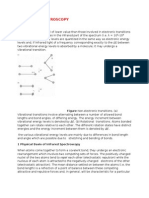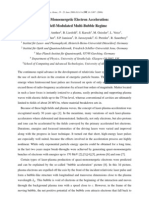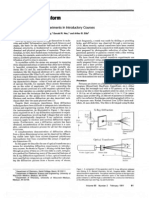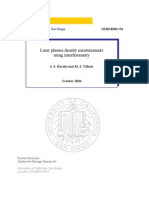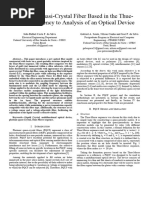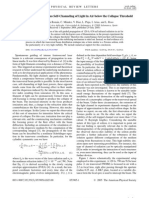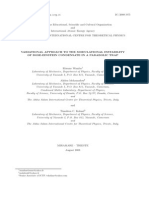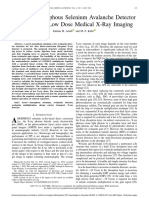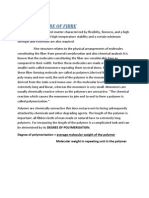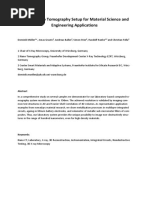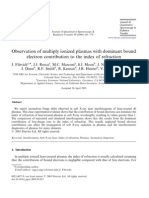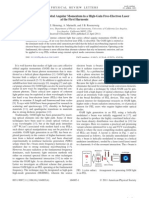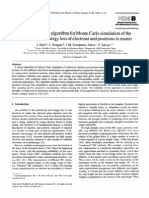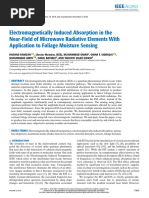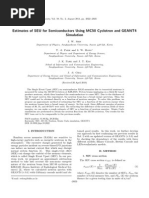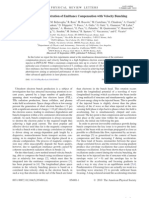Single-Shot Coherent Diffraction Imaging of Microbunched Relativistic Electron Beams For Free-Electron Laser Applications
Single-Shot Coherent Diffraction Imaging of Microbunched Relativistic Electron Beams For Free-Electron Laser Applications
Uploaded by
Particle Beam Physics LabCopyright:
Available Formats
Single-Shot Coherent Diffraction Imaging of Microbunched Relativistic Electron Beams For Free-Electron Laser Applications
Single-Shot Coherent Diffraction Imaging of Microbunched Relativistic Electron Beams For Free-Electron Laser Applications
Uploaded by
Particle Beam Physics LabOriginal Title
Copyright
Available Formats
Share this document
Did you find this document useful?
Is this content inappropriate?
Copyright:
Available Formats
Single-Shot Coherent Diffraction Imaging of Microbunched Relativistic Electron Beams For Free-Electron Laser Applications
Single-Shot Coherent Diffraction Imaging of Microbunched Relativistic Electron Beams For Free-Electron Laser Applications
Uploaded by
Particle Beam Physics LabCopyright:
Available Formats
Single-Shot Coherent Diffraction Imaging of Microbunched Relativistic Electron Beams
for Free-Electron Laser Applications
A. Marinelli,
1
M. Dunning,
2
S. Weathersby,
2
E. Hemsing,
2
D. Xiang,
2
G. Andonian,
1
F. OShea,
1
Jianwei Miao,
1
C. Hast,
2
and J. B. Rosenzweig
1
1
Department of Physics and Astronomy, University of California Los Angeles, Los Angeles, California 90095, USA
2
SLAC National Accelerator Laboratory, Menlo Park, California 94025, USA
(Received 12 July 2012; published 1 March 2013)
With the advent of coherent x rays provided by the x-ray free-electron laser (FEL), strong interest has
been kindled in sophisticated diffraction imaging techniques. In this Letter, we exploit such techniques for
the diagnosis of the density distribution of the intense electron beams typically utilized in an x-ray FEL
itself. We have implemented this method by analyzing the far-eld coherent transition radiation emitted
by an inverse-FEL microbunched electron beam. This analysis utilizes an oversampling phase retrieval
method on the transition radiation angular spectrum to reconstruct the transverse spatial distribution of the
electron beam. This application of diffraction imaging represents a signicant advance in electron beam
physics, having critical applications to the diagnosis of high-brightness beams, as well as the collective
microbunching instabilities aficting these systems.
DOI: 10.1103/PhysRevLett.110.094802 PACS numbers: 41.60.Cr, 41.75.Ht, 42.30.Rx
X-ray free-electron lasers (XFELs) [1,2] are a unique
tool for the investigation of ultra-small and ultra-fast
systems, permitting unprecedented studies of atomic-
molecular structure at the angstrom length and femtosec-
ond time scale. The XFEL is an example of a new class of
intense, coherent electromagnetic sources, which can be
fully exploited in measurements by the introduction of
innovative, diffraction imaging-based techniques [3,4].
Diffraction imaging requires the use of sophisticated
phase-retrieval methods that indeed permit detailed inves-
tigations of spatial structures down to the x-ray diffraction
limit. This new approach to imaging, stimulated by the
burgeoning availability of coherent sources, is rapidly
diffusing into a wide range of different applications. In
this vein, we extend diffraction imaging techniques to a
new frontier application in the physics of intense electron
beams and provide a rst demonstration of the newly
proposed method.
An XFEL is a complex system that may be described as
a controlled beam-radiation instability. The successful op-
eration of an XFEL requires use of a low-emittance, high
peak current electron beam. The generation, compression,
and transport of such high-brightness relativistic electron
beams poses many challenges, due particularly to parasitic
beam instabilities that amplify the beams shot-noise-
derived microbunching during beam compression. This
type of collective effect may be broadly identied as the
microbunching instability (MBI) [59]. The MBI may
generate strong perturbations in the beams longitudinal
phase space which serve to reduce the efciency of the
downstream FEL [6,10]. Most importantly, MBI may also
induce the emission of coherent optical transition radiation
(coherent OTR, or COTR) in beam diagnostics [1114],
severely compromising the utility of optical transition
radiation-based measurements. While the effect of the
microbunching instability on the FEL performance per se
can be mitigated using a laser heater [10], this approach
does not effectively suppress COTR emission in diagnos-
tics [10]. This situation renders conventional OTR-based
diagnostics ineffective for compressed high-brightness
electron beams.
In this Letter, utilizing methods originally employed in
coherent x-ray imaging, we propose and experimentally
test a method that exploits the coherent radiation rather
than attempting to avoid or eliminate coherence effects in
beam diagnostics. This approach, which uses the micro-
bunching present in an electron beam to give a single-shot,
far-eld COTR image, yields a robust path for the recon-
struction of the transverse spatial structure of the beam
microbunching. We report on the experimental demonstra-
tion of this technique at the Next Linear Collider Test
Accelerator (NLCTA), located at the SLAC National
Accelerator Laboratory.
The coherent imaging technique proposed provides a
general method for the reconstruction of the beam micro-
bunching prole from the far-eld COTR image. This
technique has a number of important applications that
depend on how the microbunching arises in the electron
beam. For example, it can be applied as an advanced
diagnostic for the FEL interaction, in which the entire
electron beam transverse prole contributes to the for-
mation of microbunching. It can also be applied to yet
more complex cases, as typied by the space-charge
induced optical microbunching, in which the beam den-
sity modulation may be transversely incoherent [8,9], or
to novel types of microbunching with more complex
topological dependencies. An example of the latter case
is found in the helical microbunching structure used to
PRL 110, 094802 (2013)
P HYS I CAL RE VI E W L E T T E RS
week ending
1 MARCH 2013
0031-9007,13,110(9),094802(5) 094802-1 2013 American Physical Society
drive the emission of orbital angular momentum modes
in FELs [1517]. In this Letter, we will focus on a seeded
scenario, in which the microbunching is generated uni-
formly across the transverse beam prole by the interac-
tion of the beam with an external laser in a magnetic
undulator. This represents a specic type of the inverse
FEL interaction, here referred to as laser-induced micro-
bunching (LIM). This case is particularly convenient,
since, with the laser turned off, it allows straightforward
benchmarking of our coherent imaging technique with
the incoherent OTR image of the beams transverse pro-
le. In this regard, it should be noted that reconstruction
of the beam prole from LIM demonstrated here can be
used to determine compressed beam distributions even in
the presence of the MBI, as the LIM-derived coherent
signal can easily be made to dominate over that due to the
MBI. This provides an alternative solution to the mitiga-
tion of COTR in FEL injector diagnostics (see also
Refs. [18,19]). In fact, the LIM may generally provide
a direct map of the three-dimensional beam density dis-
tribution. A similar approach has also been proposed in a
related context: the reconstruction of the beams longi-
tudinal prole, in a scheme known as an optical replica
synthesizer [20]. In contrast, we will refer to the trans-
verse reconstruction technique introduced here as the
transverse optical replica (TOR). We note the attractive
possibility that combining the two techniques would
allow the single shot reconstruction of the three-
dimensional electron beam structure [21]. Its also worth
pointing out that the combination of the TOR technique
with ultra-short seed laser pulses would allow the time
resolved determination of the transverse distribution of
the electron beam at the few femtosecond time scale.
Finally, we note that the TOR measurement could also be
extended to cases in which no external seed is available
such as the MBI. Generally the microbunching induced
by the MBI is transversely incoherent [11], which means
that the reconstruction of microbunching does not repro-
duce the beams transverse prole. However, the effect of
transverse Landau damping induced by emittance [8,9]
can be exploited through e-beam transport to induce
transversely uniform microbunching to be used as a
map of the density distribution. In this scenario, the
TOR reconstruction technique captures only the fraction
of the electron bunch that contributes to the coherent
emission, which is typically the part of the bunch that
lies close to the current peak.
The emission of coherent radiation from a relativistic
electron beam requires the formation of a density modula-
tion on the scale of the radiation wavelength. The beam
density modulation can be described by the 3D bunching
factor, dened as:
~
lx, y, k
z
1
N
Z
Jzx, y, ze
|kz
z
, (1)
where z is the longitudinal position along the beam axis,
x, y are the transverse positions, x, y, z is the
three-dimensional beam density distribution, N is the num-
ber of electrons in the beam, and z
n
is the longitudinal
position of the nth electron. Note that
~
l is a three-
dimensional extension of the one-dimensional bunching
factor commonly used in free-electron laser theory [22].
The experimental goal we are pursuing here is to
reconstruct the spatial dependence of
~
lx, y, k
z
from a
single-shot COTR image by analyzing the beams coherent
emission characteristics. Near-eld imaging of COTR
yields a complex pattern given by the convolution of
~
l
with the OTR near-eld Greens function [21], which
differs drastically from the transverse distribution of
~
l
(for example, the near-eld COTR image of an axisym-
metric microbunched beam has a ringlike structure [13]).
This means that direct near-eld imaging of a micro-
bunched beam prole is not possible, even in the case of
uniform microbunching. Far-eld imaging yields a more
direct path to unfold the microbunching transverse struc-
ture from the coherent radiation pattern. To understand this
approach, we rst introduce the far-eld COTR differential
power spectrum emitted by a microbunched beam, dened
as the energy radiated per unit frequency and unit solid
angle [23]
JP
JwJ
JP
JwJ
s
N
2
jBk
x
, k
y
, k
z
j
2
, (2)
where
JP
JwJ
j
s
e
2
4ce
0
r
3
2
sin
2
0
1
2
cos
2
0
2
indicates the single par-
ticle differential radiation spectrum, e is the electron
charge, c is the speed of light, e
0
is the vacuum permittiv-
ity, and is the beam velocity normalized to the speed
of light. The polar angle is related to k
x
, k
y
, k
z
by
cos0
k
2
x
k
2
y
p
k
2
x
k
2
y
k
2
z
p
. The form factor B, or beam diffraction
pattern, is dened as the 3D Fourier transform of the
beams charge density distribution:
Bk
x
, k
y
, k
z
1
N
Z
JxJyJz x, y, ze
|k
x
x|k
y
y|k
z
z
. (3)
~
lx, y, k
z
and Bk
x
, k
y
, k
z
are a two-dimensional Fourier
transform pair, i.e.,
Bk
x
, k
y
, k
z
Z
JxJy
~
l x, y, k
z
e
|k
x
x|k
y
y
. (4)
From the above denitions, it follows that, from a far-
eld COTR image one can measure the amplitude of B.
The spatial dependence of the beam microbunching can
be recovered by an inverse discrete Fourier transform.
However, to invert the discrete Fourier transform, one
must also have information about the complex phase of
B, which cannot be inferred directly from the far-eld
image. It has been recently understood that the phase
PRL 110, 094802 (2013)
P HYS I CAL RE VI E W L E T T E RS
week ending
1 MARCH 2013
094802-2
of a 2D signal can be recovered by means of an iterative
phase-retrieval algorithm, provided that jBk
x
, k
y
, k
z
j is
sampled with high enough resolution in the frequency
domain. The criterion that needs to be satised is Jk
2r,OL
s
[24] where Jk is the resolution in the transverse
frequency domain, L
s
is the characteristic size of the beam
in the space-domain and O >
2
p
is the oversampling ratio.
In practice, L
s
is chosen as the size of a nite support in x, y
that fully contains the signal. This criterion is often
referred to as the oversampling condition.
Iterative phase-retrieval algorithms (see, e.g.,
Refs. [24,25]) are now used in a great number of advanced
applications, such as coherent diffraction imaging of non-
crystalline samples [26]. Figure 1 shows a schematic of the
algorithm, which begins by application of a random phase
to the signal in the frequency domain. An inverse fast
Fourier transform (IFFT) is then applied to obtain a trial
signal in the spatial domain. At this point, a given set of
constraints (discussed below) is applied in the spatial
domain and a fast Fourier transform (FFT) is performed.
Finally, one substitutes the amplitude in the frequency
domain with the measured amplitude, while keeping the
phase from the FFT. This process is repeated for multiple
iterations (typically a few hundred to thousands) until the
amplitude of the nal FFT is equal to the measured ampli-
tude within a small tolerance.
The constraints applied in the spatial domain depend on
the type of measurement performed but usually include a
support constraint; i.e., the signal in x, y is constrained to
vanish outside a given nite support [25]. Furthermore, if
the beam microbunching is real and positive in the spatial
domain, a positivity constraint can be applied by keeping
just the real part of the spatial-domain signal and setting to
zero all data points having a negative value. The positivity
constraint increases the speed of the reconstruction algo-
rithm and ensures the uniqueness of the solution [25]. This
constraint can be applied in the case of LIM induced by a
laser that is larger than the transverse size of the beam,
which is the physical scenario of interest in this Letter. In
this case, it can be shown that the microbunching distri-
bution is
~
l /
R
Jzx, y, z [21], which is an everywhere
positive function that represents the transverse prole of
the electron bunch.
To test the proposed method, we have performed a LIM-
seeded COTR experiment at the NLCTA. The experimen-
tal schematic is shown in Fig. 2. It corresponds to the rst
part of the echo beam line, which has been used for echo-
enabled harmonics experiments in recent years [27,28]. An
electron beam of energy E 120 MeV is sent through an
undulator, co-propagating with a resonant laser of wave-
length 800 nm. The resonant interaction generates an
energy modulation in the electron beam which is then
transformed into density modulation by a subsequent mag-
netic chicane. The electron beamis nally directed through
a metal foil, causing emission of a COTR pulse that is
detected by a CCD camera. The far-eld pattern is col-
lected with a commercial Navitar compound lens focused
to innity. A bandpass lter with a bandwidth of 10 nm is
used to eliminate the higher harmonics of the COTR pulse.
The seed laser transverse size signicantly exceeds that of
the electron beam, giving a nearly transversely uniform
electric eld that interacts with the beam electrons. Thus,
the microbunching is, to an excellent approximation, a
replica of the transverse shape of the electron beam.
Since, in the experiment, we used an uncompressed beam
which is not notably affected by the MBI, the coherent
measurement can be benchmarked by comparison with a
near-eld incoherent OTR image obtained with no LIM
applied, obtained by focusing the CCD camera on the OTR
screen.
Figure 3 shows a far-eld COTR image and the inferred
beam form factor. Since the COTR single particle differ-
ential intensity is zero on axis, B cannot be measured for
k
x
0, k
y
0. The amplitude of B close to the axis is then
reconstructed by the retrieval algorithm simply keeping the
amplitude and phase of the IFFT near the axis as the last
step of each iteration. This issue is analogously found in
coherent diffraction imaging experiments with x rays,
where the near-axis diffraction pattern is dominated by
the direct beam (see, e.g., Ref. [26]) and is commonly
referred to as the missing center problem. Note also that
Fig. 3 shows a slight asymmetry in the far-eld pattern.
This is due to residual dispersion in the bunching chicane
and to uctuations in the orbit of the electrons, which
generate a slight tilt of the microbunching with respect to
the z axis (see, e.g., Ref. [8]). This issue can be solved by
shifting the far-eld pattern so that the center of mass of the
form factor lies on the k
x
0, k
y
0 point. Finally, we
Generate
Random Phase
Apply Phase to
Measured Amplitude
in Frequency Domain
Apply Constraints
in Space Domain
IFFT
FFT
FIG. 1 (color). Schematics of a phase-retrieval algorithm.
Electron Beam
Undulator
Electron-Laser
Interaction
Metal Foil
Magnetic
Chicane
Microbunched
Beam
800 nm Seed
Laser
Coherent Transi-
tion Radiation
Electron
Trajectory
CCD
FIG. 2 (color). Layout of the experimental setup.
PRL 110, 094802 (2013)
P HYS I CAL RE VI E W L E T T E RS
week ending
1 MARCH 2013
094802-3
note that the two-peak structure shown in Fig. 3 results
from the vertical beam distribution shown in Fig. 4, which
gives a horizontal form factor and, thus, a two-lobed far-
eld radiation pattern. The right plot on Fig. 3 shows the
reconstructed phase of B. Figure 4 shows the resulting
transverse dependence of the beam microbunching
~
lx, y, k
z
and an incoherent OTR image of the beam. For
ease of comparison the x and y projections of the recon-
structed and measured beam distribution are shown. The
relative error e in the reconstructed image is dened as the
absolute value of the difference between the measured and
reconstructed form factors, integrated over the far-eld
plane, normalized to the integrated amplitude of the mea-
sured form factor. The error tolerance of the reconstruction
was set to e <10
5
.
The NLCTA beam possesses small shot-to-shot uctua-
tions of the beam transverse shape, which gives some
slight variations in the comparison beam proles, permit-
ting a benchmarking of the measurement limited to the
uctuation levels. Even considering this limitation, there
are numerous repeatable features of the beam prole that
support comparison. The root mean square (rms) sizes for
the reconstructed and OTR proles, averaged over 20
shots, are respectively a
x,rec
197 17 m and
a
x,OTR
201 11 m for the horizontal axis and
a
y,rec
317 28 m and a
y,OTR
308 18 m for
the vertical axis. Finally, Fig. 5 shows the use of the
reconstruction technique for a different beam line congu-
ration, yielding a horizontal beam distribution. In this
case the rms sizes for the reconstructed and OTR proles,
averaged over 20 shots, are respectively a
x,rec
33448 m and a
x,OTR
343 33 m for the hori-
zontal axis and a
y,rec
172 52 m and a
y,OTR
167 49 m for the vertical axis. The two methods
yield consistent results well within the uctuations
level, providing a benchmarking to the newly introduced
coherent imaging approach. The rms variance in the mea-
surement is mostly due to shot to shot beam size
x (m)
y
(
m
)
500 1000 1500
500
1000
1500
0.5
1
1.5
2
2.5
3
3.5
R
e
c
o
n
s
t
r
u
c
t
e
d
D
e
n
s
i
t
y
(
a
r
b
.
u
n
i
t
s
)
x (m)
y
(
m
)
500 1000 1500
500
1000
1500
0
500
1000
1500
O
T
R
I
n
t
e
n
s
i
t
y
(
a
r
b
.
u
n
i
t
s
)
0 500 1000 1500
x (m)
P
r
o
j
e
c
t
e
d
X
P
r
o
f
i
l
e
(
a
r
b
.
u
n
i
t
s
)
OTR profile
Reconstructed
profile
2000 0 500 1000 1500 2000
0
0.2
0.4
0.6
0.8
1
y (m)
P
r
o
j
e
c
t
e
d
Y
P
r
o
f
i
l
e
(
a
r
b
.
u
n
i
t
s
)
OTR profile
Reconstructed
profile
0
0.2
0.4
0.6
0.8
1
FIG. 4 (color). Reconstructed microbunching in the space do-
main from the diffraction pattern in Fig. 3 (upper left image). For
comparison an incoherent OTR image is shown (the upper right
image). The bottom images show the x and y projected proles
of both images.
0.5
1
1.5
2
2.5
x (m)
y
(
m
)
500 1500 2500
500
1500
2500
R
e
c
o
n
s
t
r
u
c
t
e
d
D
e
n
s
i
t
y
(
a
r
b
.
u
n
i
t
s
)
x (m)
y
(
m
)
500 1500 2500
500
1500
2500
0
200
400
600
800
1000
1200
1400
1600
O
T
R
I
n
t
e
n
s
i
t
y
(
a
r
b
.
u
n
i
t
s
)
0 1000 2000 3000 4000
0
0.2
0.4
0.6
0.8
1
x(m)
P
r
o
j
e
c
t
e
d
X
P
r
o
f
i
l
e
(
a
r
b
.
u
n
i
t
s
)
OTR profile
Reconstructed
profile
0 1000 2000 3000 4000
0
0.2
0.4
0.6
0.8
1
y(m)
P
r
o
j
e
c
t
e
d
Y
P
r
o
f
i
l
e
(
a
r
b
.
u
n
i
t
s
)
OTR profile
Reconstructed
profile
FIG. 5 (color). Reconstructed microbunching (upper left im-
age) and near eld OTR image (upper right image) for a beam
line conguration yielding a horizontal beam. The bottom im-
ages show the x and y projected proles of both images.
2 1 0 1 2
x 10
4
x 10
4
x 10
4
x 10
4
x 10
4
x 10
4
500
1000
1500
2000
2500
3000
3500
4000
4500
5000
k
x
(rad/m) k
x
(rad/m)
k
x
(rad/m)
k
y
(
r
a
d
/
m
)
k
y
(
r
a
d
/
m
)
k
y
(
r
a
d
/
m
)
I
n
t
e
n
s
i
t
y
(
a
r
b
.
u
n
i
t
s
)
2 1 0 1 2
2
1.5
1
0.5
0
0.5
1
1.5
2 0
100
200
300
400
500
F
o
r
m
F
a
c
t
o
r
B
(
a
r
b
.
u
n
i
t
s
)
3
2
1
0
1
2
3
P
h
a
s
e
(
R
a
d
.
)
2.4
1.6
0.8
0
0.8
1.6
2.4
2.4 1.6 0.8 0 0.8 1.6 2.4
2
1.5
1
0.5
0
0.5
1
1.5
2
FIG. 3 (color). Raw far-eld COTR image (left image), inferred amplitude of the beams form factor (center image), and
reconstructed phase in the frequency domain (right image).
PRL 110, 094802 (2013)
P HYS I CAL RE VI E W L E T T E RS
week ending
1 MARCH 2013
094802-4
uctuations and is not inherent to the measurement tech-
nique. The spatial resolution of the coherent diffraction
imaging method is determined by the inverse of the highest
spatial frequency effectively measured in the far-eld
image, which depends on several factors such as the elec-
tron beam size at the OTR screen, the CCD dynamic range,
and the angular aperture of the collection optics. In gen-
eral, the design of the experimental setup has to balance the
need for strong oversampling, which requires the far-eld
image to occupy a large number of pixels, with the push for
high resolution, which requires high intensity per pixel (so
that the high spatial frequency components of the signal are
well above the instrumental noise). In the measurements
reported, the resolution is estimated to be approximately
one fourth of the rms beam size.
In conclusion, in this Letter, we have introduced, and
experimentally tested, a new diffraction imaging-based
technique for the single-shot reconstruction of the trans-
verse shape of beam microbunching for a relativistic elec-
tron beam. This technique is based on far-eld COTR
imaging and on application of a phase-retrieval algorithm.
We have demonstrated this method for the case of laser-
induced microbunching, in a seeded COTR experiment.
This technique is generally applicable, and may be
extended to measure arbitrary microbunching structures.
The case of laser induced microbunching is of relevance to
current and future XFELs since it extends the OTR-based
prole measurements to compressed beams, even in the
presence of COTR induced by the MBI. Further, we note
that by combining this measurement to those discussed in
Ref. [20], one may obtain a 3D replica of the beam distri-
bution. Finally, in the absence of externally imposed
microbunching, the method promises to be a keen tool in
unfolding the details of the transverse spatial distribution
of the collective instability-induced microbunching itself.
The authors would like to acknowledge C. C. Chen for
his help with the coding of the phase-retrieval algorithm.
This research is supported by grants from U.S. DOE
Contracts No. DE-FG02-07ER46272 and No. DE-FG03-
92ER40693, Ofce of Naval Research Contract
No. N00014-06-1-0925, DARPA Contract No. N66001-
11-4197, and DOE Contract No. DE-AC02-76SF00515.
[1] P. Emma et al., Nat. Photonics 4, 641 (2010).
[2] W. Ackermann et al., Nat. Photonics 1, 336 (2007).
[3] S. Boutet et al., Science 337, 362 (2012).
[4] H. N. Chapman et al., Nat. Phys. 2, 839 (2006).
[5] M. Borland et al., Nucl. Instrum. Methods Phys. Res.,
Sect. A 483, 268 (2002).
[6] Z. Huang, M. Borland, P. Emma, J. Wu, C. Limborg,
G. Stupakov, and J. Welch, Phys. Rev. ST Accel. Beams
7, 074401 (2004).
[7] G. Stupakov and S. Heifets, Phys. Rev. ST Accel. Beams
5, 054402 (2002).
[8] D. Ratner, A. Chao, and Z. Huang, in Proceedings of the
2008 Free Electron Laser Conference, Gyeongju, Korea,
2008 (Elsevier, New York, 2008), p. 338.
[9] A. Marinelli and J. B. Rosenzweig, Phys. Rev. ST Accel.
Beams 13, 110703 (2010).
[10] Z. Huang et al., Phys. Rev. ST Accel. Beams 13, 020703
(2010).
[11] A. H. Lumpkin et al., Nucl. Instrum. Methods Phys. Res.,
Sect. A 507, 200 (2003).
[12] A. H. Lumpkin, N. Sereno, W. Berg, M. Borland, Y. Li,
and S. Pasky, Phys. Rev. ST Accel. Beams 12, 080702
(2009).
[13] H. Loos et al., Proceedings of the 2008 Free Electron
Laser Conference, Gyeongju, Korea, 2008 (JACoW,
New York, 2008), p. 485.
[14] S. Wesch et al., Proceedings of the 2009 Free Electron
Laser Conference, Liverpool, UK, 2009 (JACoW,
New York, 2009), p. 619.
[15] E. Hemsing, P. Musumeci, S. Reiche, R. Tikhoplav, A.
Marinelli, J. Rosenzweig, and A. Gover, Phys. Rev. Lett.
102, 174801 (2009).
[16] E. Hemsing, A. Marinelli, and J. B. Rosenzweig, Phys.
Rev. Lett. 106, 164803 (2011).
[17] E. Hemsing, A. Knyazik, F. OShea, A. Marinelli,
P. Musumeci, O. Williams, S. Tochitsky, and J. B.
Rosenzweig, Appl. Phys. Lett. 100, 091110 (2012).
[18] A. Lumpkin et al., in Proceedings of Particle Accelerator
Conference, Vancouver, Canada, 2009 (JACoW,
Vancouver, BC, Canada, 2009), p. 3546.
[19] C. Behrens, C. Gerth, G. Kube, B. Schmidt, S. Wesch,
and M. Yan, Phys. Rev. ST Accel. Beams 15, 062801
(2012).
[20] E. Saldin, E. Schneidmiller, and M. Yurkov, Nucl.
Instrum. Methods Phys. Res., Sect. A 539, 499 (2005).
[21] G. Geloni, P. Ilinski, E. Saldin, E. Schneidmiller, and
M. Yurkhov, arXiv:0905.1619.
[22] R. Bonifacio, C. Pellegrini, and L. Narducci, Opt.
Commun. 50, 373 (1984).
[23] Y. Shibata et al., Phys. Rev. E 49, 785 (1994).
[24] J. Miao, D. Sayre, and H. N. Chapman, J. Opt. Soc. Am. A
15, 1662 (1998).
[25] J. R. Fienup, Appl. Opt. 21, 2758 (1982).
[26] J. Miao, P. Charalambous, J. Kirz, and D. Sayre, Nature
(London) 400, 342 (1999).
[27] D. Xiang et al., Phys. Rev. Lett. 105, 114801 (2010).
[28] D. Xiang et al., Phys. Rev. Lett. 108, 024802 (2012).
PRL 110, 094802 (2013)
P HYS I CAL RE VI E W L E T T E RS
week ending
1 MARCH 2013
094802-5
You might also like
- PBPL Publications: 2009-00024: PublicationDocument7 pagesPBPL Publications: 2009-00024: PublicationParticle Beam Physics LabNo ratings yet
- Infrared Spectroscopy: Figure Non-Electronic Transitions. (A)Document4 pagesInfrared Spectroscopy: Figure Non-Electronic Transitions. (A)Chetan SharmaNo ratings yet
- Observation of Coherent Terahertz Edge Radiation From Compressed Electron BeamsDocument6 pagesObservation of Coherent Terahertz Edge Radiation From Compressed Electron BeamsParticle Beam Physics LabNo ratings yet
- 2D Photonic CrystalDocument10 pages2D Photonic CrystalXu LêNo ratings yet
- B. Hidding Et Al - Quasi-Monoenergetic Electron Acceleration: The Self-Modulated Multi-Bubble RegimeDocument4 pagesB. Hidding Et Al - Quasi-Monoenergetic Electron Acceleration: The Self-Modulated Multi-Bubble RegimeYuersNo ratings yet
- Transmission Electron Microscopy: Electron Incident Beam X-RaysDocument22 pagesTransmission Electron Microscopy: Electron Incident Beam X-RaysJaysheel BuddyNo ratings yet
- New Perspectives in Time-Resolved Laser-Induced ElDocument16 pagesNew Perspectives in Time-Resolved Laser-Induced Elalexzhang1979.0144No ratings yet
- The Optical TransformDocument6 pagesThe Optical TransformJoan MNo ratings yet
- Electron Diffraction Using Transmission Electron MicrosDocument16 pagesElectron Diffraction Using Transmission Electron MicrosRama GaurNo ratings yet
- The Resolution in The Electron MicrosDocument8 pagesThe Resolution in The Electron MicrosInternational Journal of Application or Innovation in Engineering & ManagementNo ratings yet
- Maurer 2012Document5 pagesMaurer 2012asteriNo ratings yet
- Leemans - Observation of Terahertz Emission Froma Laser-Plasma Accelerated Electron Bunch Crossing A Plasma-Vacuum BoundaryDocument4 pagesLeemans - Observation of Terahertz Emission Froma Laser-Plasma Accelerated Electron Bunch Crossing A Plasma-Vacuum BoundaryspamfakeNo ratings yet
- S. S. Harilal and M. S. Tillack - Laser Plasma Density Measurements Using InterferometryDocument14 pagesS. S. Harilal and M. S. Tillack - Laser Plasma Density Measurements Using InterferometryPocxaNo ratings yet
- Strong Optical Activity From Twisted-Cross Photonic MetamaterialsDocument3 pagesStrong Optical Activity From Twisted-Cross Photonic MetamaterialsBaban BaidyaNo ratings yet
- Photonic Quasi-Crystal Fiber Based in The Thue-Morse Sequency To Analysis of An Optical DeviceDocument5 pagesPhotonic Quasi-Crystal Fiber Based in The Thue-Morse Sequency To Analysis of An Optical Devicerafael.costa.106No ratings yet
- Twisted Lattice Nanocavity Based On Mode Locking in Momentum SpaceDocument13 pagesTwisted Lattice Nanocavity Based On Mode Locking in Momentum Space鄭彰緯No ratings yet
- Ver Ellen 2011Document7 pagesVer Ellen 2011AminKhanNo ratings yet
- Electro-Optic Sampling at 90 Degree Interaction Geometry For Time-Of-Arrival Stamping of Ultrafast Relativistic Electron DiffractionDocument7 pagesElectro-Optic Sampling at 90 Degree Interaction Geometry For Time-Of-Arrival Stamping of Ultrafast Relativistic Electron DiffractionParticle Beam Physics LabNo ratings yet
- Terahertz Ifel/Fel Microbunching For Plasma Beatwave AcceleratorsDocument3 pagesTerahertz Ifel/Fel Microbunching For Plasma Beatwave AcceleratorsParticle Beam Physics LabNo ratings yet
- Pub 00026Document7 pagesPub 00026Particle Beam Physics LabNo ratings yet
- Internal Elemental Microanalysis Combining X-Ray Fluorescence, Compton and Transmission TomographyDocument13 pagesInternal Elemental Microanalysis Combining X-Ray Fluorescence, Compton and Transmission TomographyAllendtw DtwNo ratings yet
- Absorption Spectrophotometry: No. 3 Emission Spectroscopy 117Document7 pagesAbsorption Spectrophotometry: No. 3 Emission Spectroscopy 117citraNo ratings yet
- SemDocument17 pagesSemaliveinmoscowNo ratings yet
- Photon Bubble Turbulence in Cold Atomic Gases: Joaodmrodrigues@tecnico - Ulisboa.ptDocument5 pagesPhoton Bubble Turbulence in Cold Atomic Gases: Joaodmrodrigues@tecnico - Ulisboa.ptbase1No ratings yet
- AnshuDocument9 pagesAnshusoumya jemyNo ratings yet
- Effects of Random Discrete Impurities in Ultra-Short MOSFET Using 3D Monte Carlo SimulationDocument4 pagesEffects of Random Discrete Impurities in Ultra-Short MOSFET Using 3D Monte Carlo SimulationsafigholiNo ratings yet
- W. Liu Et Al - Femtosecond Laser Pulse Filamentation Versus Optical Breakdown in H2ODocument15 pagesW. Liu Et Al - Femtosecond Laser Pulse Filamentation Versus Optical Breakdown in H2OPocxaNo ratings yet
- C. Ruiz Et Al - Observation of Spontaneous Self-Channeling of Light in Air Below The Collapse ThresholdDocument4 pagesC. Ruiz Et Al - Observation of Spontaneous Self-Channeling of Light in Air Below The Collapse ThresholdPocxaNo ratings yet
- Available At: Http://publications - Ictp.itDocument25 pagesAvailable At: Http://publications - Ictp.itEtienneNo ratings yet
- A Novel Amorphous Selenium Avalanche Detector Structure For Low Dose Medical X-Ray ImagingDocument8 pagesA Novel Amorphous Selenium Avalanche Detector Structure For Low Dose Medical X-Ray ImagingAlexandra BeltranNo ratings yet
- Investigation of Fine Structure of Textile FibreDocument12 pagesInvestigation of Fine Structure of Textile FibreSuyash Manmohan100% (1)
- Optical Manipulation of Nanoparticles: A Review: Maria Dienerowitz, Michael Mazilu, and Kishan DholakiaDocument32 pagesOptical Manipulation of Nanoparticles: A Review: Maria Dienerowitz, Michael Mazilu, and Kishan DholakiaZakir AhmedNo ratings yet
- Tremaine 1998 0423Document4 pagesTremaine 1998 0423Particle Beam Physics LabNo ratings yet
- 2018 Optics LettersDocument4 pages2018 Optics LettersAlenNo ratings yet
- Power Splitter2 CHUANDocument10 pagesPower Splitter2 CHUANQuan TruongNo ratings yet
- Charge Carrier Motion in SemiconductorsDocument3 pagesCharge Carrier Motion in SemiconductorsAngelo Faceto100% (1)
- Fabrication, Characterization, and Theoretical Analysis of Controlled Disorder in The Core of Optical FibersDocument9 pagesFabrication, Characterization, and Theoretical Analysis of Controlled Disorder in The Core of Optical Fibersjesus1843No ratings yet
- Nano 5Document18 pagesNano 5caralbmarbat_3207679No ratings yet
- J. Filevich Et Al - Observation of Multiply Ionized Plasmas With Dominant Bound Electron Contribution To The Index of RefractionDocument10 pagesJ. Filevich Et Al - Observation of Multiply Ionized Plasmas With Dominant Bound Electron Contribution To The Index of RefractionOlyvesNo ratings yet
- Longitudinal Dispersion of Orbital Angular Momentum Modes in High-Gain Free-Electron LasersDocument8 pagesLongitudinal Dispersion of Orbital Angular Momentum Modes in High-Gain Free-Electron LasersParticle Beam Physics LabNo ratings yet
- Yee Grid EigenmodesDocument13 pagesYee Grid EigenmodesmouhabaldeNo ratings yet
- overview of phase conjugation (1)Document18 pagesoverview of phase conjugation (1)fightforcashNo ratings yet
- Effective Medium Theory Applied To Photonic Crystals Composed of Cubic or Square CylindersDocument12 pagesEffective Medium Theory Applied To Photonic Crystals Composed of Cubic or Square CylindersVaswati BiswasNo ratings yet
- RFDC SputteringDocument4 pagesRFDC Sputteringसुरेन्द्र वशिष्ठNo ratings yet
- Ref 1Document34 pagesRef 1mirqadayazNo ratings yet
- Gavin D.M. Jeffries Et Al - Using Polarization Shaped Optical Vortex Traps For Single-Cell NanosurgeryDocument10 pagesGavin D.M. Jeffries Et Al - Using Polarization Shaped Optical Vortex Traps For Single-Cell NanosurgeryGmewop30mNo ratings yet
- Generating Optical Orbital Angular Momentum in A High-Gain Free-Electron Laser at The First HarmonicDocument4 pagesGenerating Optical Orbital Angular Momentum in A High-Gain Free-Electron Laser at The First HarmonicParticle Beam Physics LabNo ratings yet
- Monticone - Full Control of Nanoscale Optical Transmission With A Composite MetascreenDocument5 pagesMonticone - Full Control of Nanoscale Optical Transmission With A Composite Metascreenpatrick ferreiraNo ratings yet
- Baro 1Document16 pagesBaro 1jiar001No ratings yet
- Electromagnetically Induced Absorption in The Near-Field of Microwave Radiative Elements With Application To Foliage Moisture Sensing-1Document10 pagesElectromagnetically Induced Absorption in The Near-Field of Microwave Radiative Elements With Application To Foliage Moisture Sensing-1amin khanNo ratings yet
- Effect of Spin-Orbit Interaction On The Optical Spectra of Single-Layer, Double-Layer, and Bulk MosDocument6 pagesEffect of Spin-Orbit Interaction On The Optical Spectra of Single-Layer, Double-Layer, and Bulk MosTomás RojasNo ratings yet
- Exciton Polaritons in Single and Coupled MicrocavitiesDocument5 pagesExciton Polaritons in Single and Coupled MicrocavitiesArtemis KarvounisNo ratings yet
- PhysRevLett 130 205001Document7 pagesPhysRevLett 130 205001PedroNo ratings yet
- Estimates of SEU For Semiconductors Using MC50 Cyclotron and GEANT4 SimulationDocument4 pagesEstimates of SEU For Semiconductors Using MC50 Cyclotron and GEANT4 SimulationNguyễn Thành CôngNo ratings yet
- Yun2011Document11 pagesYun2011u1802119No ratings yet
- S41467-018-04116-9-Articol TezaDocument10 pagesS41467-018-04116-9-Articol TezaElena AnghelNo ratings yet
- STEM1Document9 pagesSTEM1UNIG Aluana SantanaNo ratings yet
- Photovoltaic Modeling HandbookFrom EverandPhotovoltaic Modeling HandbookMonika Freunek MüllerNo ratings yet
- Laser Metrology in Fluid Mechanics: Granulometry, Temperature and Concentration MeasurementsFrom EverandLaser Metrology in Fluid Mechanics: Granulometry, Temperature and Concentration MeasurementsNo ratings yet
- Electron Beam-Specimen Interactions and Simulation Methods in MicroscopyFrom EverandElectron Beam-Specimen Interactions and Simulation Methods in MicroscopyNo ratings yet
- Bruin Buy Supplier Site Order Form: Fedex International Fedex DomesticDocument1 pageBruin Buy Supplier Site Order Form: Fedex International Fedex DomesticParticle Beam Physics LabNo ratings yet
- Single-Shot Coherent Diffraction Imaging of Microbunched Relativistic Electron Beams For Free-Electron Laser ApplicationsDocument5 pagesSingle-Shot Coherent Diffraction Imaging of Microbunched Relativistic Electron Beams For Free-Electron Laser ApplicationsParticle Beam Physics LabNo ratings yet
- Stable Charged-Particle Acceleration and Focusing in A Laser Accelerator Using Spatial HarmonicsDocument5 pagesStable Charged-Particle Acceleration and Focusing in A Laser Accelerator Using Spatial HarmonicsParticle Beam Physics LabNo ratings yet
- Time-Domain Measurement of A Self-Amplified Spontaneous Emission Free-Electron Laser With An Energy-Chirped Electron Beam and Undulator TaperingDocument4 pagesTime-Domain Measurement of A Self-Amplified Spontaneous Emission Free-Electron Laser With An Energy-Chirped Electron Beam and Undulator TaperingParticle Beam Physics LabNo ratings yet
- Using The Relativistic Two-Stream Instability For The Generation of Soft-X-Ray Attosecond Radiation PulsesDocument5 pagesUsing The Relativistic Two-Stream Instability For The Generation of Soft-X-Ray Attosecond Radiation PulsesParticle Beam Physics LabNo ratings yet
- Experimental Demonstration of Emittance Compensation With Velocity BunchingDocument4 pagesExperimental Demonstration of Emittance Compensation With Velocity BunchingParticle Beam Physics LabNo ratings yet
- Longitudinal Profile Diagnostic Scheme With Subfemtosecond Resolution For High-Brightness Electron BeamsDocument8 pagesLongitudinal Profile Diagnostic Scheme With Subfemtosecond Resolution For High-Brightness Electron BeamsParticle Beam Physics LabNo ratings yet
- Self-Amplified Spontaneous Emission Free-Electron Laser With An Energy-Chirped Electron Beam and Undulator TaperingDocument4 pagesSelf-Amplified Spontaneous Emission Free-Electron Laser With An Energy-Chirped Electron Beam and Undulator TaperingParticle Beam Physics LabNo ratings yet
- Electro-Optic Sampling at 90 Degree Interaction Geometry For Time-Of-Arrival Stamping of Ultrafast Relativistic Electron DiffractionDocument7 pagesElectro-Optic Sampling at 90 Degree Interaction Geometry For Time-Of-Arrival Stamping of Ultrafast Relativistic Electron DiffractionParticle Beam Physics LabNo ratings yet
- Nonlinear Longitudinal Space Charge Oscillations in Relativistic Electron BeamsDocument4 pagesNonlinear Longitudinal Space Charge Oscillations in Relativistic Electron BeamsParticle Beam Physics LabNo ratings yet
- Resonant Excitation of Coherent Cerenkov Radiation in Dielectric Lined WaveguidesDocument3 pagesResonant Excitation of Coherent Cerenkov Radiation in Dielectric Lined WaveguidesParticle Beam Physics LabNo ratings yet
- Generating Optical Orbital Angular Momentum in A High-Gain Free-Electron Laser at The First HarmonicDocument4 pagesGenerating Optical Orbital Angular Momentum in A High-Gain Free-Electron Laser at The First HarmonicParticle Beam Physics LabNo ratings yet
- Travish 1995 0384Document387 pagesTravish 1995 0384Particle Beam Physics LabNo ratings yet

